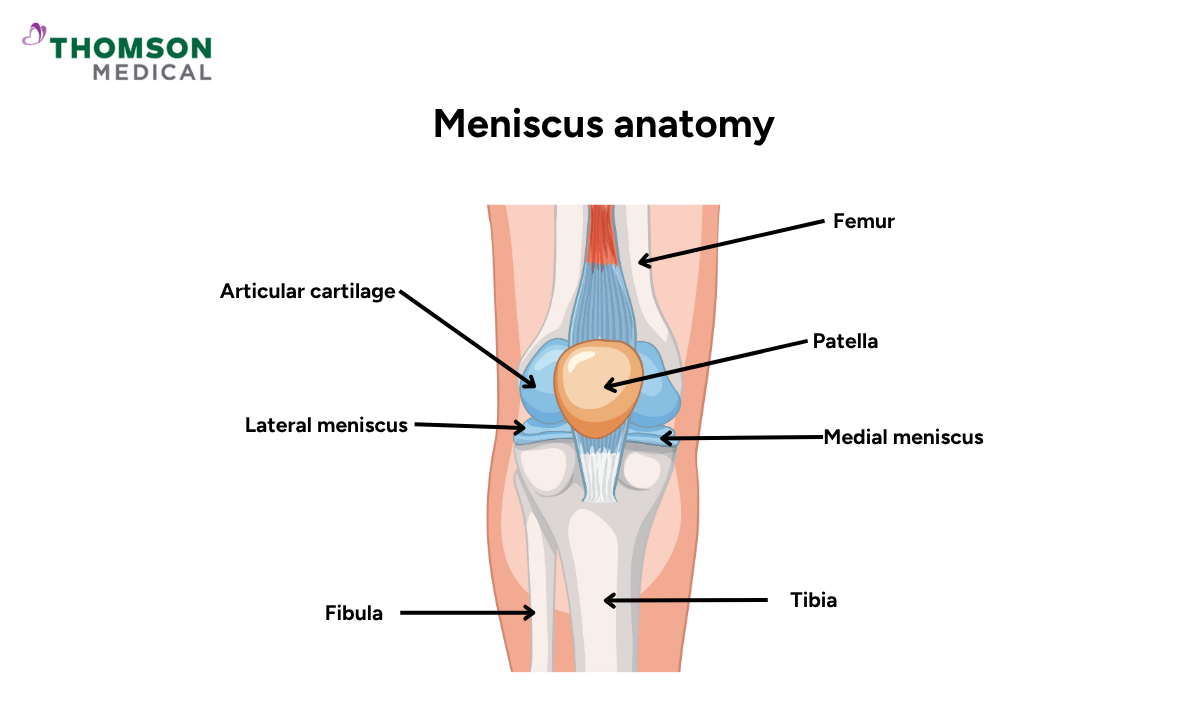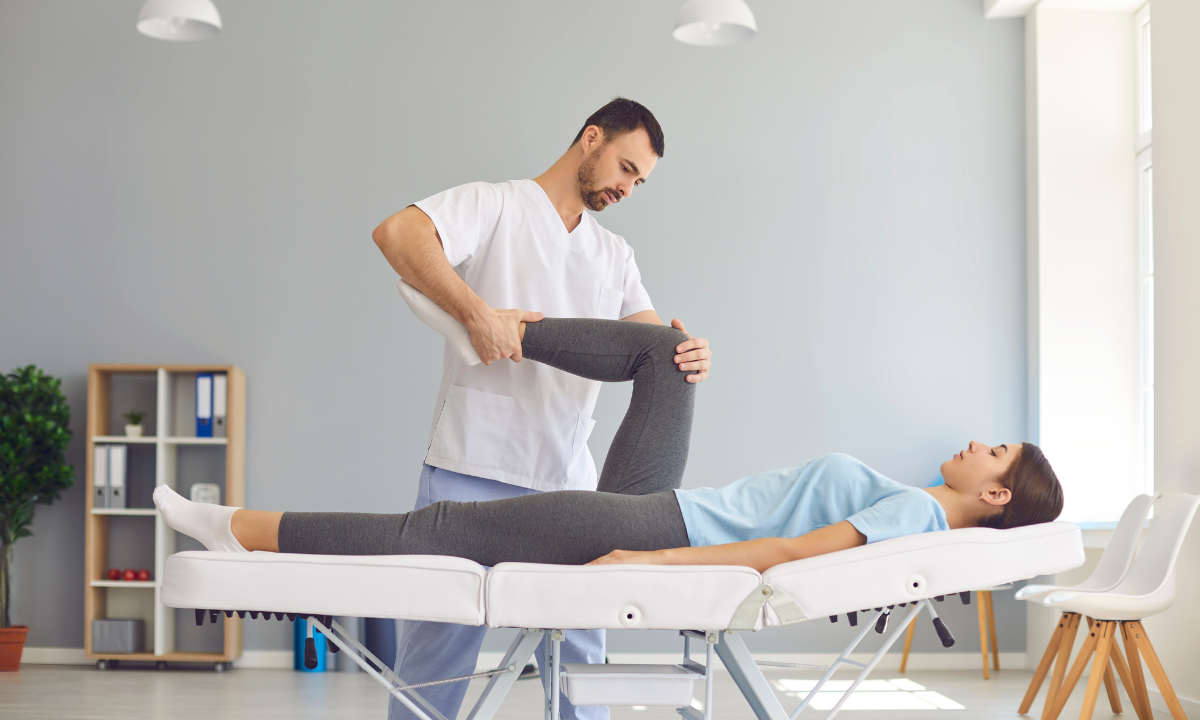Wondering why you’re having problems bending your knee? A torn meniscus might be the hidden culprit. Here’s what that means for your movement and recovery.
What is a meniscus tear?
A meniscus tear is a common knee injury that involves a tear in the cartilage called the meniscus. Each knee has two C-shaped menisci—one on the inner side (medial meniscus) and one on the outer side (lateral meniscus). These tough, rubbery cartilage pieces sit between the thighbone (femur) and shinbone (tibia). They act as shock absorbers, help cushion the knee joint, support smooth knee movement, and evenly distribute your body weight across the knee.
A tear can happen from sudden twisting movements, deep squats, lifting heavy objects, sports injury or simply from wear and tear as you get older. If not addressed, this damage can contribute to joint degeneration over time. Therefore, common signs of a meniscus tear include knee pain, swelling, stiffness, a popping sound, and difficulty bending or straightening your knee.

Common causes of a meniscus tear
A meniscus tear is one of the most common knee injuries, especially among athletes. It often occurs during activities that involve forceful twisting or sudden changes in direction, such as pivoting, turning, or stopping quickly.
Movements like deep squatting, kneeling, or lifting heavy objects can also increase the risk. In older adults, age-related wear and tear of the knee cartilage, also known as degenerative knee changes, can lead to a meniscus tear even with minimal stress.
Can you bend your knee with a torn meniscus?
Whether you can bend your knee with meniscal tears depends on several factors. Some people may still have partial mobility, while others experience significant stiffness and pain. Several factors influencing ability to bend include:
Severity of the tear:
Minor tears may allow limited bending, while larger or complex tears can significantly restrict movement.
Location of the tear:
Tears in certain areas of the meniscus (like the inner or outer edge) can affect joint movement differently.
Swelling and inflammation:
Pain, fluid build-up, and inflammation can make it difficult to bend or straighten the knee.
Time since injury:
Bending may be more restricted during the first few weeks post-injury, but can improve with proper treatment.
Individual response to injury:
Each person’s pain tolerance and muscle control can affect how much they are able to move the joint.
If you are experiencing pain, stiffness, or difficulty bending your knee, you can always request an appointment with us today and get a proper diagnosis and start your journey to recovery.
What to expect during the recovery time
Non-surgical recovery
Not all meniscus tears require surgery. Many mild to moderate cases can heal with conservative treatment. Recovery without surgery typically takes 4 to 8 weeks, depending on the severity and location of the tear. In the early stage of recovery, it's important to:
Rest your knee and avoid movements that twist, pivot, or put stress on the joint
Apply ice for 15 to 20 minutes a few times a day to relieve pain and swelling
Use a compression bandage to support the knee and minimise inflammation
Elevate your leg above heart level to reduce fluid build-up in the joint
Take anti-inflammatory medications like ibuprofen or naproxen to ease pain (only as advised by your doctor)
Use mobility aids such as crutches or a cane to reduce pressure on the injured knee
As pain and swelling improve, your doctor or physiotherapist may introduce physical therapy to help you regain movement and strength.
Moreover, rehabilitation typically includes:
Range of motion exercises to reduce stiffness and improve flexibility
Muscle strengthening exercises targeting the quadriceps and hamstrings to enhance knee stability
Progressive activity levels, with adjustments based on how well your knee is healing
Throughout the recovery process, it’s important to follow up with your healthcare provider to monitor progress and make any necessary adjustments to your treatment plan.
Surgical recovery
Surgery may be recommended when non-surgical treatments do not provide relief. The two main surgical options for a torn meniscus are meniscus repair and partial meniscectomy. The most suitable approach depends on the type, size, and location of the tear. Your doctor will help you decide which procedure is best for your condition.
Meniscus repair involves stitching the torn meniscus back together. This option is generally chosen when the tear is in a region with good blood supply. Recovery can take 3 to 6 months, depending on the complexity of the tear.
Partial meniscectomy involves removing the damaged portion of the meniscus using the arthroscopic surgery process while preserving the healthy tissue. Recovery usually takes 4 to 6 weeks.
Most meniscus surgeries are performed as outpatient procedures, allowing patients to go home the same day. In some cases, an overnight hospital stay may be required for monitoring.
Post-surgery care typically includes:
Resting the knee and avoiding movements that twist, rotate, or place stress on the joint
Applying ice for 15 to 20 minutes a few times a day to manage pain and swelling
Using a compression bandage to support the knee and reduce inflammation
Elevating the leg above heart level to decrease swelling
Taking pain relief medications such as ibuprofen or naproxen (as prescribed)
Using crutches or a cane to reduce weight bearing on the knee during the early stages
Once pain and swelling are under control, your recovery plan will include physical therapy to restore knee function.
Rehabilitation will focus on:
Range of motion exercises to improve flexibility and reduce joint stiffness
Strength training exercises for muscles around the knee, especially the quadriceps and hamstrings
Gradual progression of activity, adjusted by your physiotherapist based on your healing progress
Regular follow-ups with your healthcare provider are essential to monitor recovery and ensure a safe return to daily activities or sports.
Factors affecting the recovery process of a torn meniscus

Recovery from a meniscus injury varies from person to person. Several factors influence how quickly and effectively the knee heals, including age, type of tear, treatment approach, and how well the rehabilitation plan is followed.
Age and activity level
Age and pre-injury activity levels play a key role in recovery outcomes. Younger individuals who were physically active before the injury often recover faster and return to higher levels of activity. However, recovery can be similar across age groups if both young and older patients maintain comparable fitness levels and follow their rehab plan closely.
Type and severity of the tear
Minor tears:
Small or incomplete tears often respond well to non-surgical treatment, including rest, ice, physical therapy, and pain management.
Moderate tears (partial tears):
These may require a combination of conservative treatments and, in some cases, surgical intervention depending on the location and severity of the tear.
Severe tears:
Complete tears, bucket handle tears, or complex tears typically require surgery to repair or remove the damaged portion of the meniscus.
Treatment plan and adherence
The success of recovery largely depends on following a structured treatment plan. Key components include:
Rest, ice, compression, and elevation (RICE) to control swelling and pain
A personalised physiotherapy programme to regain strength and mobility
Consistent participation in rehab exercises and follow-up sessions
Clear communication with your healthcare team
Patience and commitment to the full recovery timeline
Sticking to your rehabilitation plan and attending regular check-ins with your doctor or physiotherapist can significantly improve long-term outcomes and reduce the risk of re-injury.
FAQ
Is it okay to bend the knee with a torn meniscus?
Bending the knee is generally not recommended in the initial stages of a meniscus tear or during the early weeks following meniscus surgery. Excessive bending, especially twisting or squatting, can worsen the injury and delay healing.
What are 3 common signs of a meniscus tear in the knee?
Symptoms of a meniscus tear in the knee usually include:
Knee pain, especially when twisting or rotating
Swelling and stiffness in the joint
A feeling of instability or the knee giving way
How can I check myself for a torn meniscus?
While only a doctor can confirm a diagnosis, certain symptoms may suggest a meniscus injury—such as pain, swelling, stiffness, locking, or a feeling that the knee is unstable. A few self-check tests include:
Apley’s compression test:
Lie face down, bend the knee, and apply downward pressure while rotating the foot. Pain or clicking may indicate a tear.
Squat test (Ege’s test):
Stand with feet shoulder-width apart, squat down, and stand up slowly. Discomfort or clicking may suggest a meniscus issue.
Thessaly test:
Stand on the affected leg with the knee slightly bent, then twist your upper body left and right. Pain or instability may signal a tear.
Is it okay to stretch with a torn meniscus?
Stretching can be beneficial during the recovery process but should only be done under the supervision of a healthcare professional. Gentle stretching helps maintain flexibility, reduce stiffness, and strengthen muscles around the knee.
What is the fastest way to heal a torn meniscus?
The quickest path to recovery often includes:
RICE protocol – rest, ice, compression, and elevation
Targeted physiotherapy to restore strength and mobility
Surgery if conservative treatment fails or the tear is severe
Following your doctor’s instructions closely is key to speeding up recovery.
Should I wear a knee brace with a torn meniscus?
Yes, a knee brace can provide support and stability, reduce pain and swelling, and help prevent further injury. It is often recommended during both conservative and post-surgical recovery.
The information provided is intended for general guidance only and should not be considered medical advice. For personalised recommendations and tailored advice, please consult a specialist at Thomson Medical. Request an appointment with Thomson Medical today.
For more information, contact us:
Thomson Specialists (Thomson Medical Centre) — Orthopaedic
Request an Appointment